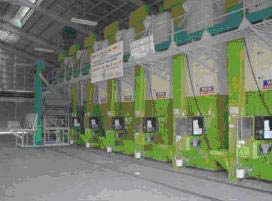How to use a dryer
 What is a dryer?
What is a dryer?
A dryer is a mechanical device or machine that removes the water from wet grains by forcing either ambient air or heated air through the grain bulk.
Why is proper usage of a dryer important?
Any delay in drying of wet paddy leads to rapid deterioration of quality. A dryer that does not perform well or is not operated properly can cause several problems:
- Extended drying time due to inefficient air delivery or low temperature
- Uneven drying of grains due to uneven airflow or very high temperature (batch dryers)
- High fuel consumption due to ineffective air distribution or very high airflow rate
- Low germination rate due to very high drying air temperatures
- High number of broken grains due to mixing of dry with wet grains or due to moisture gradient
- Fire hazard and danger of carbon monoxide (CO) poisoning of operators from using unsafe burners
What is the proper way of drying?
For optimum drying, apply proper pre-drying management and operate the dryer according to the manual.
Before drying
- Prevent any delay in drying after harvest. If you cannot dry the paddy to the desired moisture content, at least pre-dry it to 18%, which is safe for temporary storage for up to two weeks.
- Clean the grains before drying to avoid uneven drying and wet spots.
- Do not mix grains with different moisture contents to avoid cracking.
- Read the operator’s manual and familiarize yourself with the dryer operation.
Using the dryer
- Load the dryer with wet paddy, considering the minimum load. Do not overload.
- With very wet paddy or when paddy lots with different moisture contents are mixed, aerate or circulate the grains for 15−30 min before turning the heater on to reduce broken grains.
- In a batch dryer with more than 30 cm grain depth, mix the grains at least once for more even drying.
- Monitor grain temperature and moisture content to prevent excess temperature and over drying.
- Dry paddy after harvest to 18% moisture content for storage up to two weeks.
- Dry paddy for milling to 14% moisture content. Drying below 14% reduces weight and milling yield.
- For 8−12-month storage, dry to 13% or less; for long-term storage exceeding 1 year, dry to 9%.
Safety precautions
- Always operate the dryer following the steps given in the manual.
- Check burners or furnaces regularly to prevent fire hazards and excess CO production. Always have a fire extinguisher at hand.
- Make sure that fuel cut-off valves that disconnect the fuel supply in case of power cuts are functioning.
- Ensure proper ventilation in the working area to prevent CO poisoning.
For more information:
email postharvest@irri.org; or call +63 2 580 5600
Prepared by M Gummert with inputs from JF Rickman (2004); updated by M Gummert (2010)